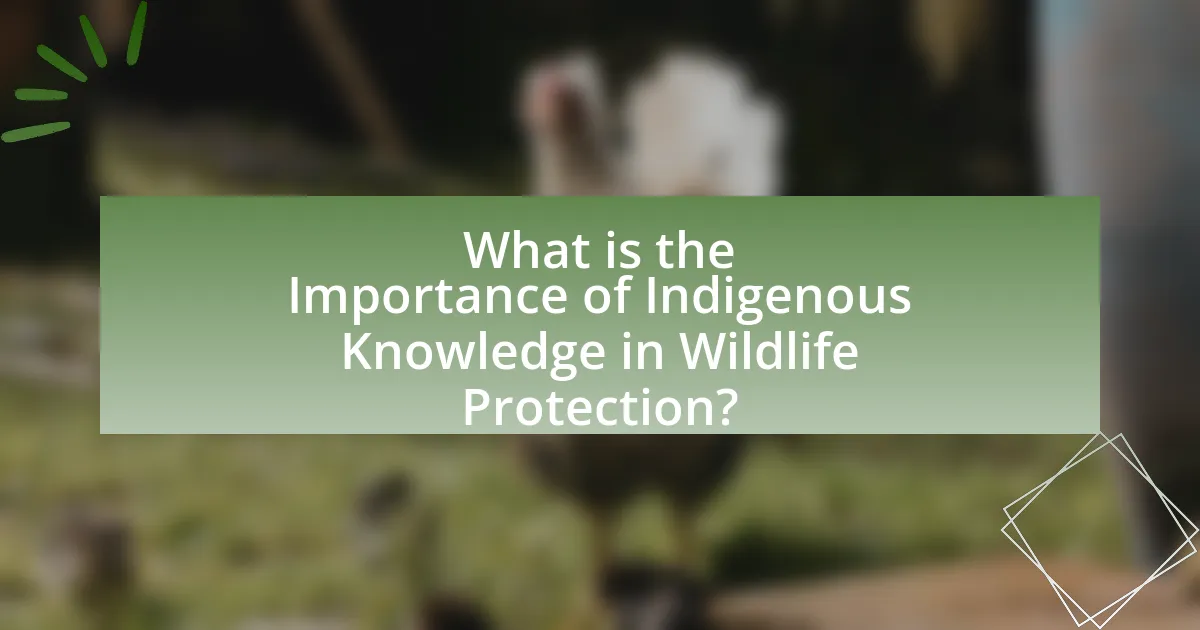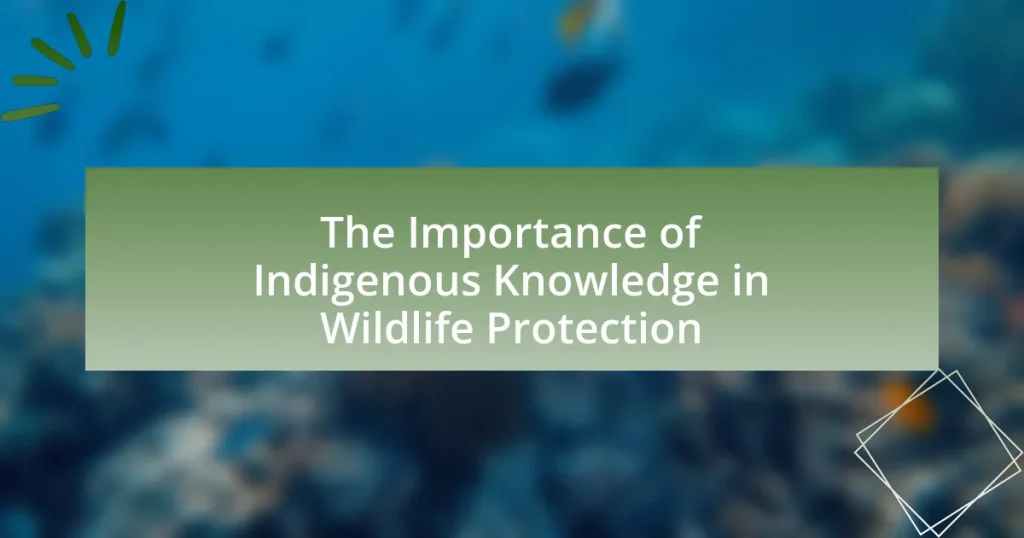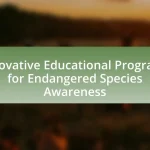The article focuses on the significance of Indigenous knowledge in wildlife protection, highlighting its role in enhancing biodiversity and ecosystem health through traditional ecological practices. It discusses how Indigenous communities utilize sustainable resource management techniques, such as rotational hunting and fishing, which contribute to higher biodiversity levels compared to conventional methods. The integration of Indigenous knowledge into modern conservation strategies is emphasized, showcasing successful partnerships between Indigenous peoples and conservation organizations. Additionally, the article addresses the challenges faced in recognizing and utilizing Indigenous knowledge and outlines best practices for collaboration to ensure effective wildlife protection.

What is the Importance of Indigenous Knowledge in Wildlife Protection?
Indigenous knowledge is crucial in wildlife protection as it encompasses traditional ecological wisdom that has been developed over generations. This knowledge includes understanding local ecosystems, species behavior, and sustainable resource management practices that are often more effective than modern scientific approaches. For instance, studies have shown that Indigenous-managed lands often exhibit higher biodiversity and healthier ecosystems compared to areas managed solely by conventional methods. This is evidenced by research conducted by the United Nations Environment Programme, which highlights that Indigenous territories cover about 22% of the Earth’s surface and contain 80% of the planet’s remaining biodiversity. Thus, integrating Indigenous knowledge into wildlife protection strategies enhances conservation efforts and promotes ecological sustainability.
How does Indigenous Knowledge contribute to wildlife conservation efforts?
Indigenous Knowledge contributes to wildlife conservation efforts by integrating traditional ecological practices with contemporary conservation strategies. This knowledge encompasses a deep understanding of local ecosystems, species behavior, and sustainable resource management, which has been developed over generations. For instance, Indigenous communities often employ rotational hunting and fishing practices that prevent overexploitation, as evidenced by studies showing that areas managed by Indigenous peoples have higher biodiversity levels compared to those without such management. Furthermore, Indigenous Knowledge systems emphasize the spiritual and cultural significance of wildlife, fostering a sense of stewardship that enhances conservation outcomes.
What traditional practices are utilized in wildlife protection?
Traditional practices utilized in wildlife protection include community-based conservation, sacred sites, and sustainable hunting methods. Community-based conservation involves local communities managing natural resources, which has been shown to enhance biodiversity and ecosystem health. Sacred sites, often designated by indigenous cultures, serve as protected areas that preserve habitats and species, as evidenced by the success of such sites in various regions globally. Sustainable hunting methods, guided by traditional ecological knowledge, ensure that wildlife populations remain stable while allowing for subsistence needs, as demonstrated by practices that align hunting seasons with animal breeding cycles. These practices collectively highlight the effectiveness of indigenous knowledge in maintaining wildlife populations and ecosystems.
How does Indigenous Knowledge enhance biodiversity management?
Indigenous Knowledge enhances biodiversity management by integrating traditional ecological practices with contemporary conservation strategies. This knowledge, developed over generations, includes insights into local ecosystems, species behavior, and sustainable resource use, which can lead to more effective management practices. For example, Indigenous communities often employ rotational hunting and fishing methods that prevent overexploitation, thereby maintaining population levels and ecosystem balance. Studies have shown that areas managed by Indigenous peoples often exhibit higher biodiversity and resilience compared to those managed solely by conventional methods, as evidenced by research published in the journal “Nature” which highlights the positive impact of Indigenous stewardship on biodiversity conservation.
Why is Indigenous Knowledge crucial for sustainable wildlife management?
Indigenous Knowledge is crucial for sustainable wildlife management because it encompasses a deep understanding of local ecosystems, species behavior, and sustainable practices developed over generations. This knowledge is often based on long-term observations and interactions with the environment, which can lead to effective conservation strategies that align with ecological balance. For instance, Indigenous communities have historically utilized practices such as rotational hunting and fishing, which help maintain population levels and biodiversity. Research indicates that areas managed by Indigenous peoples often show higher biodiversity and healthier ecosystems compared to those managed by conventional methods, highlighting the effectiveness of Indigenous approaches in wildlife management.
What are the long-term benefits of integrating Indigenous Knowledge into conservation strategies?
Integrating Indigenous Knowledge into conservation strategies leads to enhanced biodiversity preservation and sustainable resource management. Indigenous communities possess a deep understanding of local ecosystems, which can inform effective conservation practices that are culturally relevant and ecologically sound. For instance, studies have shown that areas managed by Indigenous peoples often exhibit higher levels of biodiversity compared to those under conventional management. This is evidenced by research published in the journal “Nature” (2020) by Berkes and Folke, which highlights that Indigenous stewardship practices contribute to the resilience of ecosystems. Additionally, incorporating Indigenous Knowledge fosters community engagement and ownership, ensuring that conservation efforts are supported and maintained over the long term.
How does Indigenous Knowledge address contemporary wildlife challenges?
Indigenous Knowledge addresses contemporary wildlife challenges by integrating traditional ecological practices with modern conservation strategies. This knowledge system emphasizes sustainable resource management, which has been proven effective in maintaining biodiversity and ecosystem health. For instance, Indigenous communities often employ rotational hunting and fishing practices that prevent overexploitation, as seen in the practices of the Inuit in Canada, who have managed Arctic wildlife sustainably for generations. Additionally, Indigenous Knowledge includes an understanding of local ecosystems and species behaviors, which can inform contemporary conservation efforts, such as habitat restoration and species reintroduction programs. Studies have shown that areas managed by Indigenous peoples often exhibit higher biodiversity compared to those managed solely by governmental entities, highlighting the effectiveness of this knowledge in addressing wildlife challenges.
What role do Indigenous communities play in wildlife protection?
Indigenous communities play a crucial role in wildlife protection through their traditional ecological knowledge and sustainable practices. This knowledge, accumulated over generations, informs conservation strategies that are often more effective than conventional methods. For instance, Indigenous land management practices, such as controlled burns, have been shown to enhance biodiversity and reduce the risk of catastrophic wildfires, as evidenced by studies in Australia and North America. Furthermore, Indigenous peoples often advocate for the protection of their ancestral lands, which are vital habitats for numerous species, thereby contributing to broader conservation efforts. Their involvement in wildlife management not only preserves biodiversity but also fosters a deeper connection between communities and their natural environments.
How do Indigenous peoples’ rights influence wildlife conservation policies?
Indigenous peoples’ rights significantly influence wildlife conservation policies by integrating traditional ecological knowledge and land stewardship practices into modern conservation strategies. This integration is evident in various legal frameworks, such as the United Nations Declaration on the Rights of Indigenous Peoples, which emphasizes the importance of Indigenous participation in decision-making processes regarding natural resource management. For instance, in Canada, the rights of Indigenous communities have led to co-management agreements that recognize their authority over local wildlife populations, resulting in more effective conservation outcomes. Studies show that areas managed by Indigenous peoples often exhibit higher biodiversity and healthier ecosystems, demonstrating the effectiveness of their traditional practices in wildlife conservation.
What partnerships exist between Indigenous communities and conservation organizations?
Partnerships between Indigenous communities and conservation organizations often focus on collaborative management of natural resources, integrating traditional ecological knowledge with scientific approaches. For example, the Indigenous-led initiative “Guardians of the North” in Canada partners with conservation groups to protect caribou habitats, demonstrating the effectiveness of combining Indigenous stewardship with conservation efforts. Additionally, the “Indigenous Protected and Conserved Areas” (IPCAs) framework allows Indigenous communities to manage lands and waters, supported by organizations like the Nature Conservancy of Canada, which recognizes the value of Indigenous knowledge in biodiversity conservation. These partnerships are validated by studies showing that areas managed by Indigenous peoples often have higher biodiversity and resilience to climate change.
How can Indigenous Knowledge be effectively integrated into modern conservation practices?
Indigenous Knowledge can be effectively integrated into modern conservation practices by recognizing and valuing the traditional ecological knowledge held by Indigenous communities. This integration involves collaborative partnerships where Indigenous peoples are actively involved in decision-making processes regarding land management and conservation strategies. For instance, the incorporation of Indigenous fire management techniques has been shown to enhance biodiversity and reduce wildfire risks, as evidenced by studies in Australia where traditional burning practices have led to healthier ecosystems. Furthermore, respecting Indigenous land rights and ensuring their participation in conservation initiatives can lead to more sustainable outcomes, as demonstrated by the success of co-management agreements in various regions globally.
What challenges exist in recognizing and utilizing Indigenous Knowledge in wildlife protection?
Recognizing and utilizing Indigenous Knowledge in wildlife protection faces several challenges, primarily due to systemic marginalization and differing worldviews. Indigenous Knowledge is often overlooked in favor of Western scientific approaches, leading to a lack of integration in policy-making. Additionally, there is a historical context of distrust between Indigenous communities and governmental bodies, which hampers collaboration. For instance, the United Nations Declaration on the Rights of Indigenous Peoples emphasizes the importance of Indigenous Knowledge, yet implementation remains inconsistent across various regions. Furthermore, legal frameworks often do not adequately protect Indigenous rights to land and resources, limiting their ability to contribute effectively to wildlife conservation efforts.
What are the best practices for collaborating with Indigenous communities in wildlife conservation?
The best practices for collaborating with Indigenous communities in wildlife conservation include establishing respectful partnerships, integrating traditional ecological knowledge, and ensuring equitable participation in decision-making processes. Respectful partnerships involve recognizing Indigenous rights and sovereignty, which fosters trust and mutual understanding. Integrating traditional ecological knowledge enhances conservation efforts, as Indigenous communities possess valuable insights about local ecosystems and species, often accumulated over generations. Ensuring equitable participation means involving Indigenous peoples in all stages of conservation projects, from planning to implementation, which has been shown to improve conservation outcomes and community well-being, as evidenced by successful initiatives like the Indigenous Guardians program in Canada, where Indigenous-led management has led to increased biodiversity and habitat restoration.
How can conservationists build trust with Indigenous communities?
Conservationists can build trust with Indigenous communities by actively involving them in decision-making processes regarding conservation efforts. This approach acknowledges the value of Indigenous knowledge and fosters collaboration, which is essential for effective wildlife protection. For instance, studies have shown that when Indigenous peoples are included in conservation planning, such as the co-management of protected areas, the outcomes are more successful and sustainable. A notable example is the partnership between the Australian government and Indigenous landowners in managing the Kakadu National Park, which has led to improved biodiversity outcomes and strengthened community ties.
What strategies can be employed to respect and incorporate Indigenous Knowledge in wildlife protection?
Strategies to respect and incorporate Indigenous Knowledge in wildlife protection include collaborative management, integrating traditional ecological knowledge (TEK) into conservation practices, and fostering partnerships between Indigenous communities and conservation organizations. Collaborative management involves co-developing wildlife management plans that reflect Indigenous perspectives and practices, ensuring that Indigenous voices are integral to decision-making processes. Integrating TEK into conservation practices can enhance biodiversity outcomes, as Indigenous communities often possess valuable insights into local ecosystems, species behavior, and sustainable practices developed over generations. Fostering partnerships can facilitate knowledge exchange, capacity building, and mutual respect, leading to more effective wildlife protection strategies. For example, the partnership between the Kuku Yalanji people and the Australian government in the Daintree Rainforest demonstrates how Indigenous knowledge can inform conservation efforts, resulting in improved ecological outcomes and cultural preservation.




